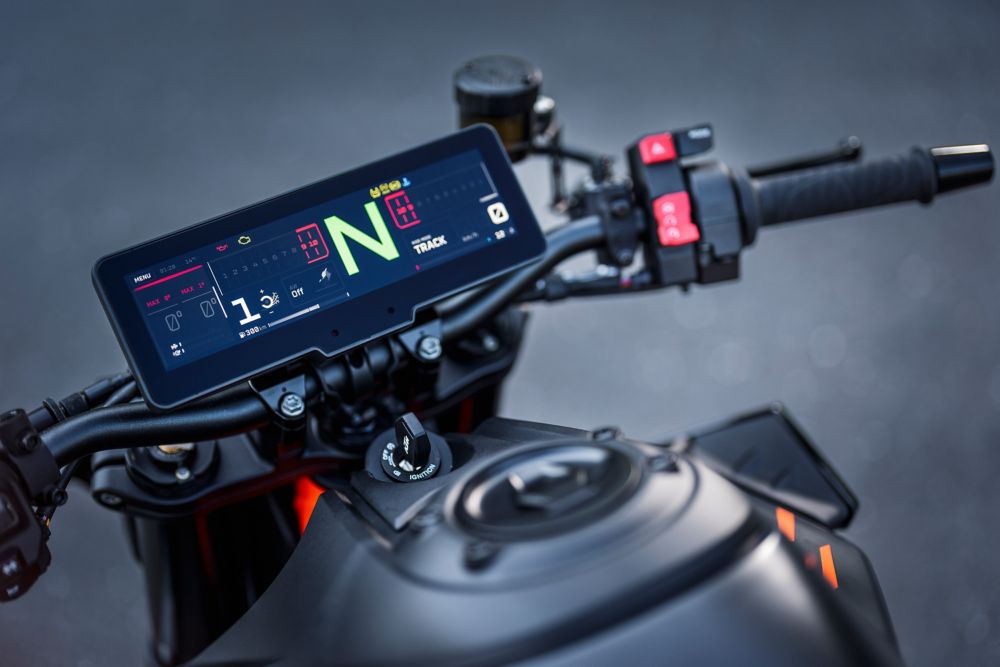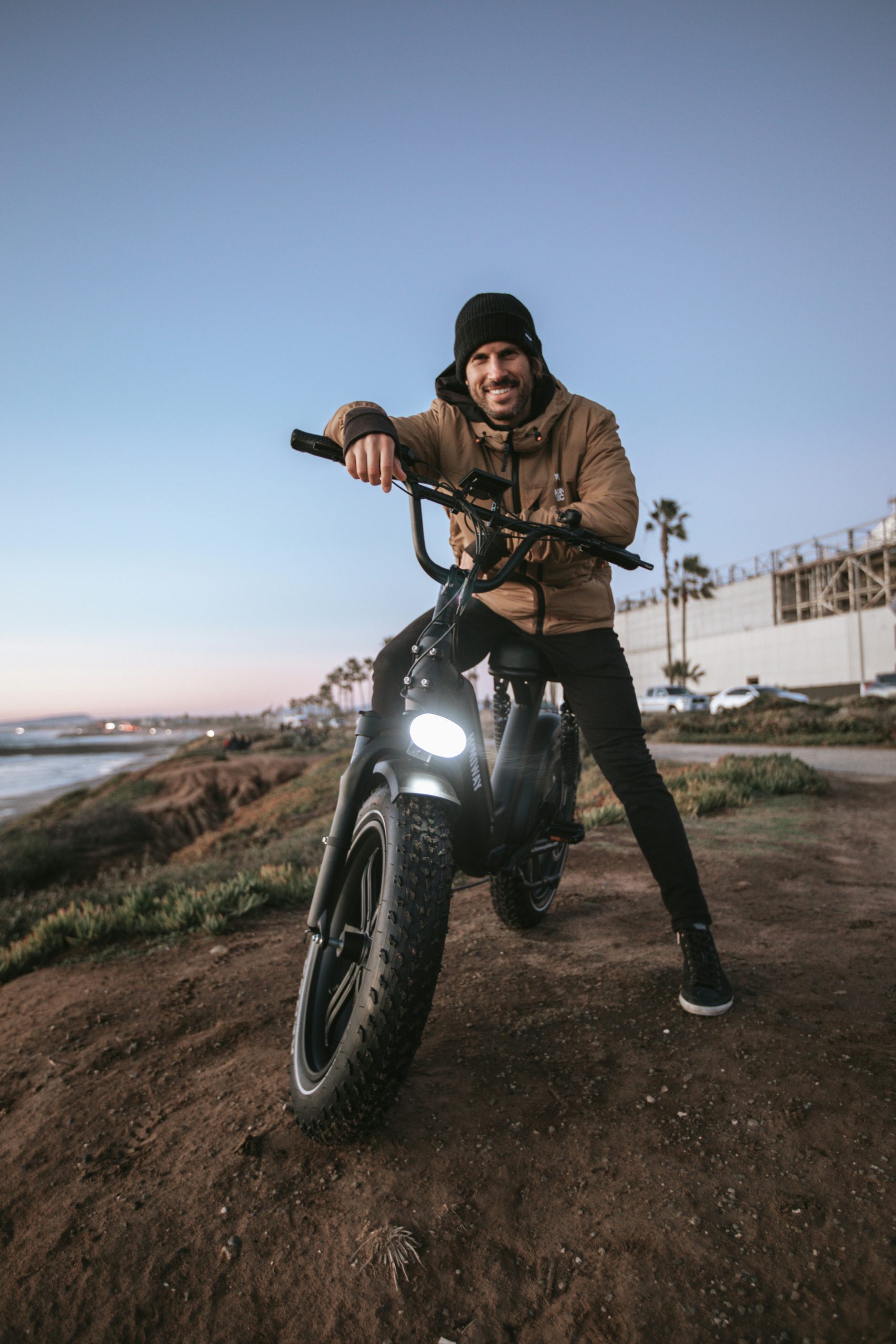A couple of weeks ago, a press release from KTM made us sit up and take notice. This was KTM talking about a pair of new TFT displays. This two-part series analyzes how this is a wake-up call for the electric motorcycle world.
KTM’s Awesome Displays of the Future
KTM’s first display is a vertical 8-inch display, and the other is a horizontal 8.8-inch display. Both come with a new connectivity unit and handlebar switchgear and are a couple of generations ahead of the present crop of TFT screens on KTM Motorcycles. The displays have touch functionality and can, KTM says, be used with gloves on. There is an emphasis on UX/UI and rider-focused functionality. The shortcut buttons on the main screen eliminate the need for auxiliary switches. What is impressive is the 1280×720 resolution with 256k colors, a big jump from the 65k colors the previous units came with.
KTM has integrated offline map navigation into the motorcycle connectivity unit along with the new TFTs. This provides active route guidance, planning, and real-time navigation without syncing or tethering to a mobile phone.
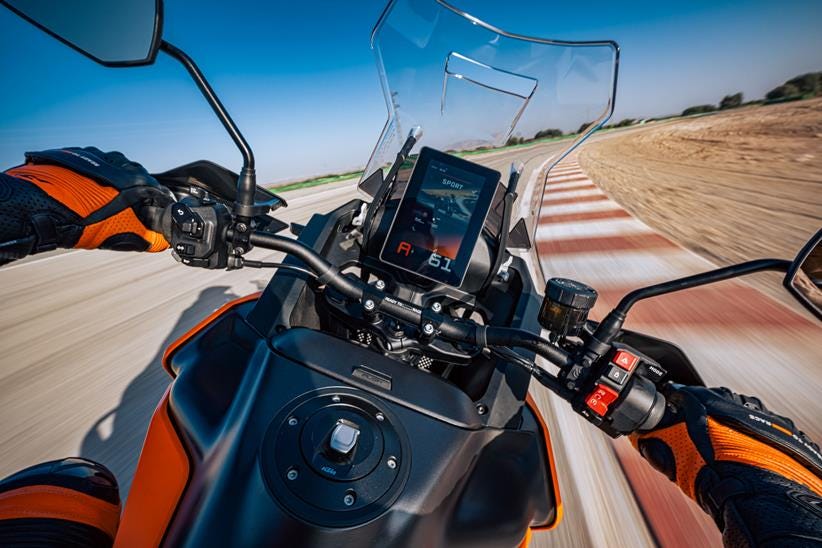
The TFTs run the Android Automotive Operating System and are powered by an upgraded CCU 3.0 connectivity unit with 32 GB of storage and 3 GB of RAM. IoT connectivity is achieved through an eSim, a GPS Antenna, Bluetooth, and Wi-Fi.
At least from the press release, it appears KTM has worked hard on the user interface and rider connectivity options. The CCC 3.0 ensures seamless reconnecting with the rider’s smartphone on every riding cycle, allowing riders to pick up where they left off their music app on the split screen and access the contact list from the phone. The new units will allow apps to stream to the dashboard. KTM does not discuss over-the-air updates but mentions the possibility of enabling them.
The TFTs are much-needed as the KTM brand is refocusing on the high-end Adventure and touring audience, where the much bigger rival BMW has a lead. While BMW does not put the best of its displays on the R 1300GS (BMW has yet to figure out a large vertical display), larger and more informative displays are where the world is headed.
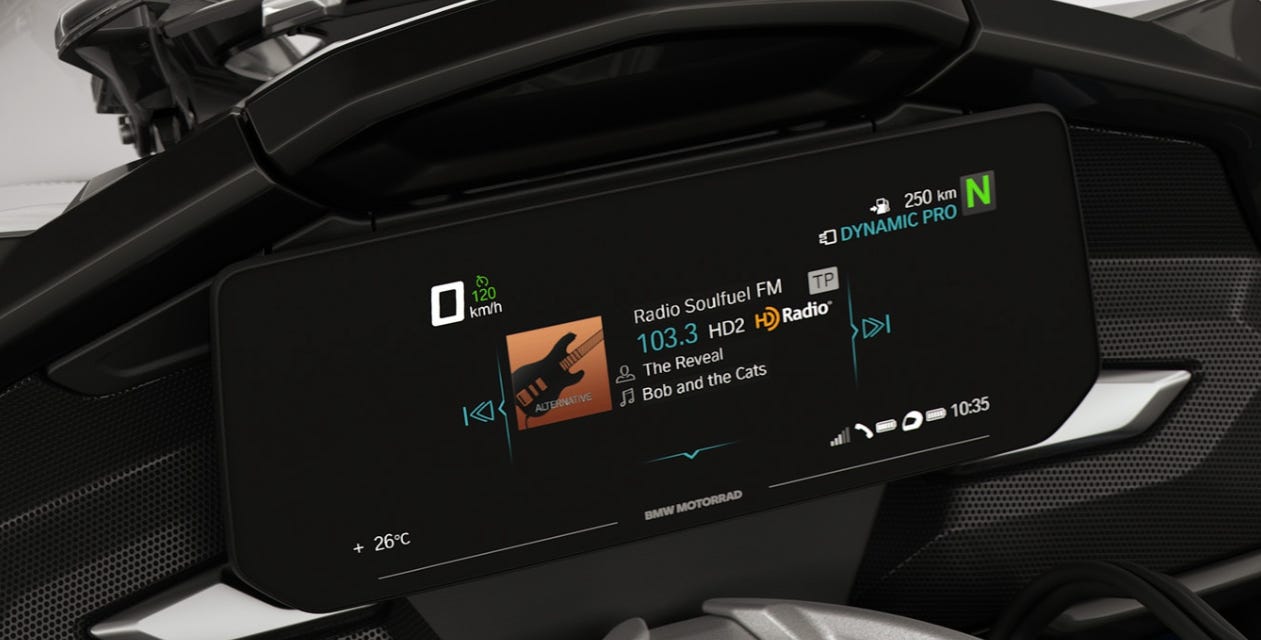
BMW saves the best of its displays for the K 1600 GT tourers, which are 10.25-inch TFTs. Sadly, BMW does not believe in motorcycle touch displays, so the K1600 remains without touch. Functionality is handled through a twistgrip….honestly, it’s not bad!
The same display unit does duty in the BMW CE 04 electric maxi scooter.
Then there is the Ducati Multistrada’s display (below)—a 6.5” TFT screen. Again, there is no touch functionality, and a joystick handles operations. It’s even better than the BMW solution.
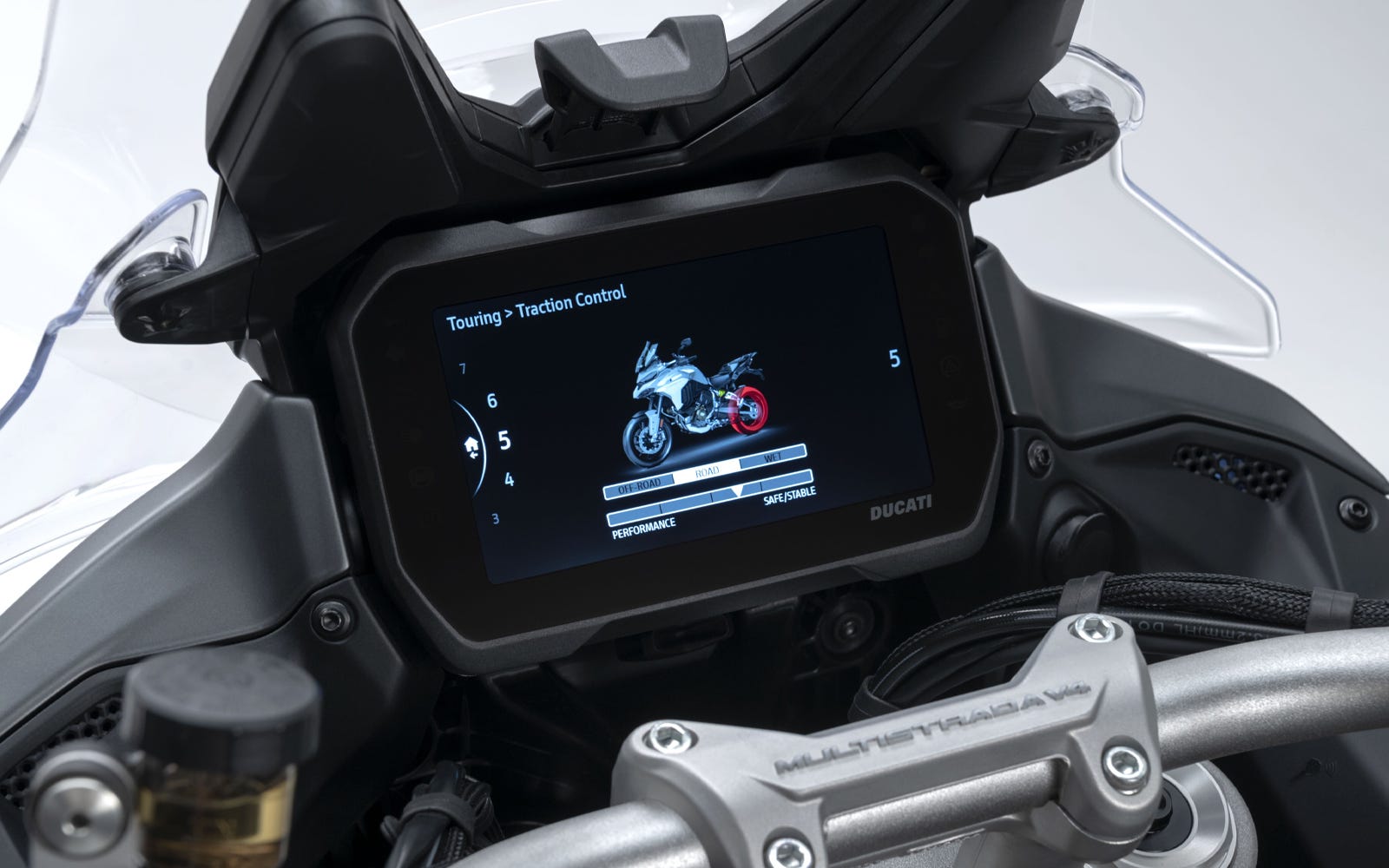
Honda is similar. Their Goldwing tourer has Apple CarPlay, but still no touch.
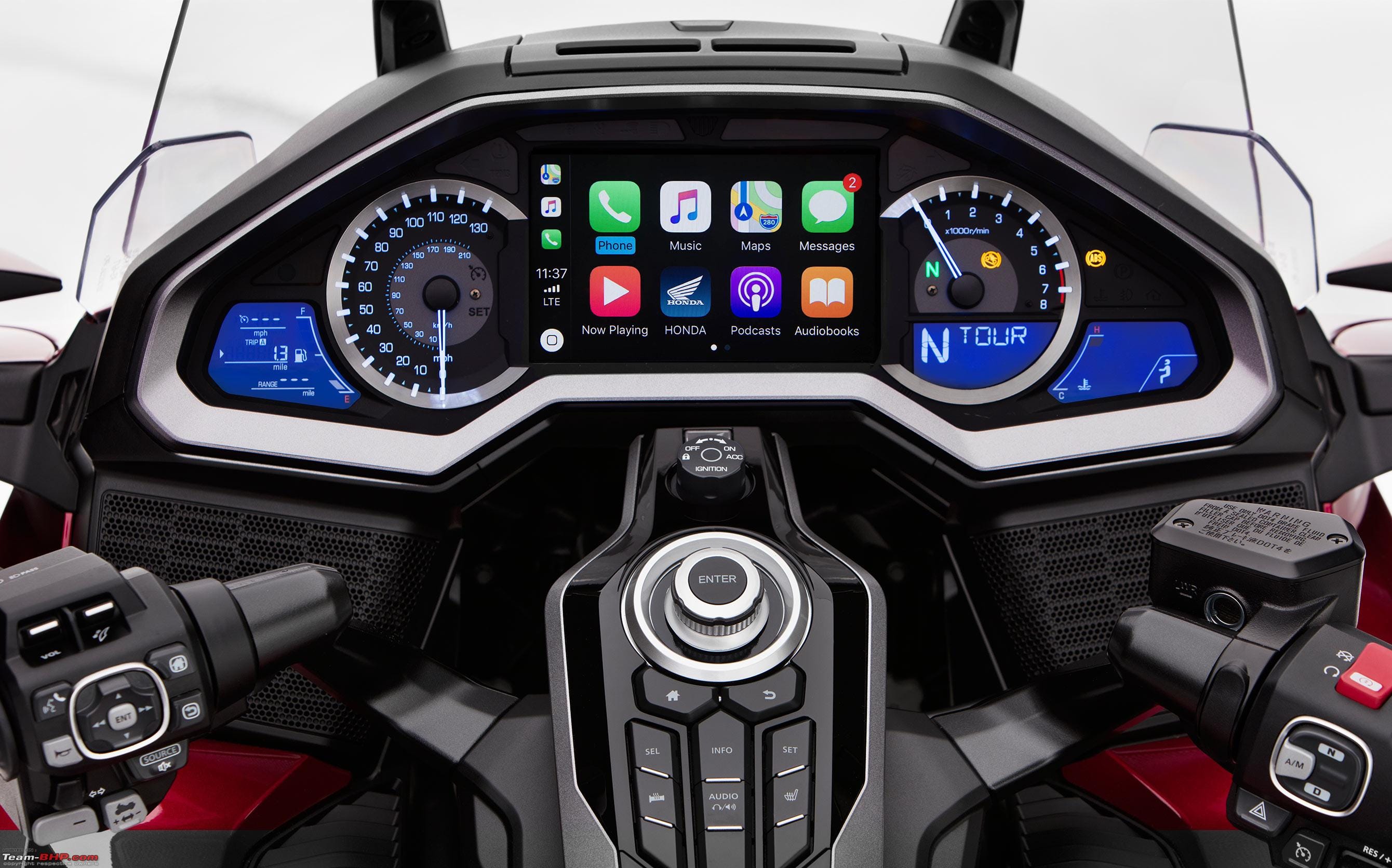
The BMW’s 10.25-inch screens are not even the biggest in the business. That honor goes to Harley’s 12.3-inch screens on the brand’s high-end tourer range. Thankfully, they have touch.
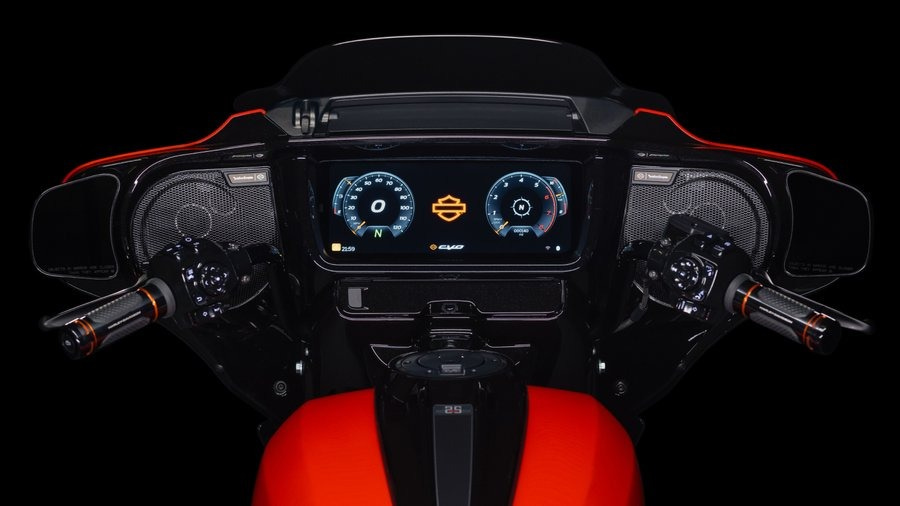
In almost all cases we have seen above, touch functionality is a rarity, even when the ICE world embraces large digital screens.
So, with major rivals shunning touch functionality, KTM’s new 8”/8.8” TFTs become even more important. In one stroke, KTM marches past the ICE competition.
It also leapfrogs over most of the EV players.
Over the years, EVs—cars and two-wheelers—have distinguished themselves with screens. On the E2W front, even the low-end ones come with digital displays, and nearly every premium electric two-wheeler has a large touchscreen display. In comparison, most ICE motorcycles still stick with analog displays, with some reluctantly adding a two-tone LCD for merit. Large digital displays are still uncommon, and touchscreens are still a rarity.
An 8.8” touchscreen? That’s the eighth wonder of the world.
Why is that?
It comes down to the software. E2Ws have always had an inherent advantage over ICE two-wheelers. With ICE, things are mechanical. The engine drives the wheels, converting thermal energy to mechanical energy. There was no space for software to do anything.
Software, the embedded type, crept in later with EFI systems, ECUs, fully adjustable suspensions, ABS, and other three-letter abbreviations that have become popular in the industry. However, these systems were all developed and supplied by large suppliers like BOSCH and Continental, and they had hundreds of software engineers in offices tucked away in India to work on the development. The OEMs need not develop a capability.
EVs are different; their stored chemical energy is converted to mechanical energy. The software can control the pace at which the energy is converted, how it is stored, what current the motor draws, and many other factors. The software ensures that the motor and battery both run optimally. Electric two-wheeler manufacturers need a capable software team to ensure that the motor and battery extract the maximum performance and range.
This is just the basics. The software drives a lot of other things. The Battery Management System (BMS) and the Motor Control Units (MCU) efficiently integrate electronic circuits and embedded software control. The software controls how much the motor spins, how much current it draws, how much the system heats before the motor gets derated, etc. The software also controls the regenerative strength of the motor battery. Regeneration recovers some of the lost energy as the vehicle slows down, but it is not as friendly in user experience as engine retardation. The software has to control it to adapt it to rider use.
Off-the-shelf BMS and MCUs are easily available, but they have limitations. Brands must also differentiate themselves, so tweaking systems is the best way forward. E2W start-ups can either build this software capability in-house or depend on external capability piecemeal. That’s never a great or responsive solution, and well-funded E2W manufacturers almost always decide to set up their teams for software development.
Over time this created a strength in software development that gave the E2W world an edge over the ICE world.
Once you have set up a capable team to handle complex tasks like extracting performance from the motor and juice from the battery, the UX/UI and human interface are relatively easy.
The quality difference in software capabilities between an EV manufacturer like Scorpio Electric or Ather Energy vs an ICE manufacturer like Harley-Davidson or even Honda can be seen in the fact that while the E2W players design their own UX/UI and an operating system (mostly a skin on the Android OS), the ICE manufacturers are content with integrating Apple CarPlay / Android Auto to provide phone connectivity.
The software hides the weaknesses.
The digits and displays also became a way of hiding weaknesses. E2Ws and ICE motorcycles are opposites. ICE two-wheelers, especially lifestyle motorcycles, have personalities. The ‘character traits’ help endear them to enthusiasts.
Electric two-wheelers lack charisma.
There is no way a 5000-rpm motor would feel any different if you switched it from a commuter scooter to an off-road motorcycle.
To hide this ‘lack of character,’ E2Ws have a cloak of features and connectivity options that have become synonymous with technology in the last decade. At the basic level, these include battery level indicators, range estimators, regenerative mode control, etc. At a slightly higher level, these may include software that controls the motor and battery and talks to the numerous sensors in the vehicle to deliver features like remote lock/unlock, proximity features, keyless start, side stand sensors, cruise control, etc.
Creating a smartphone app and presenting all these features as a visual interface for the user was a low-hanging fruit, and everyone has done that.
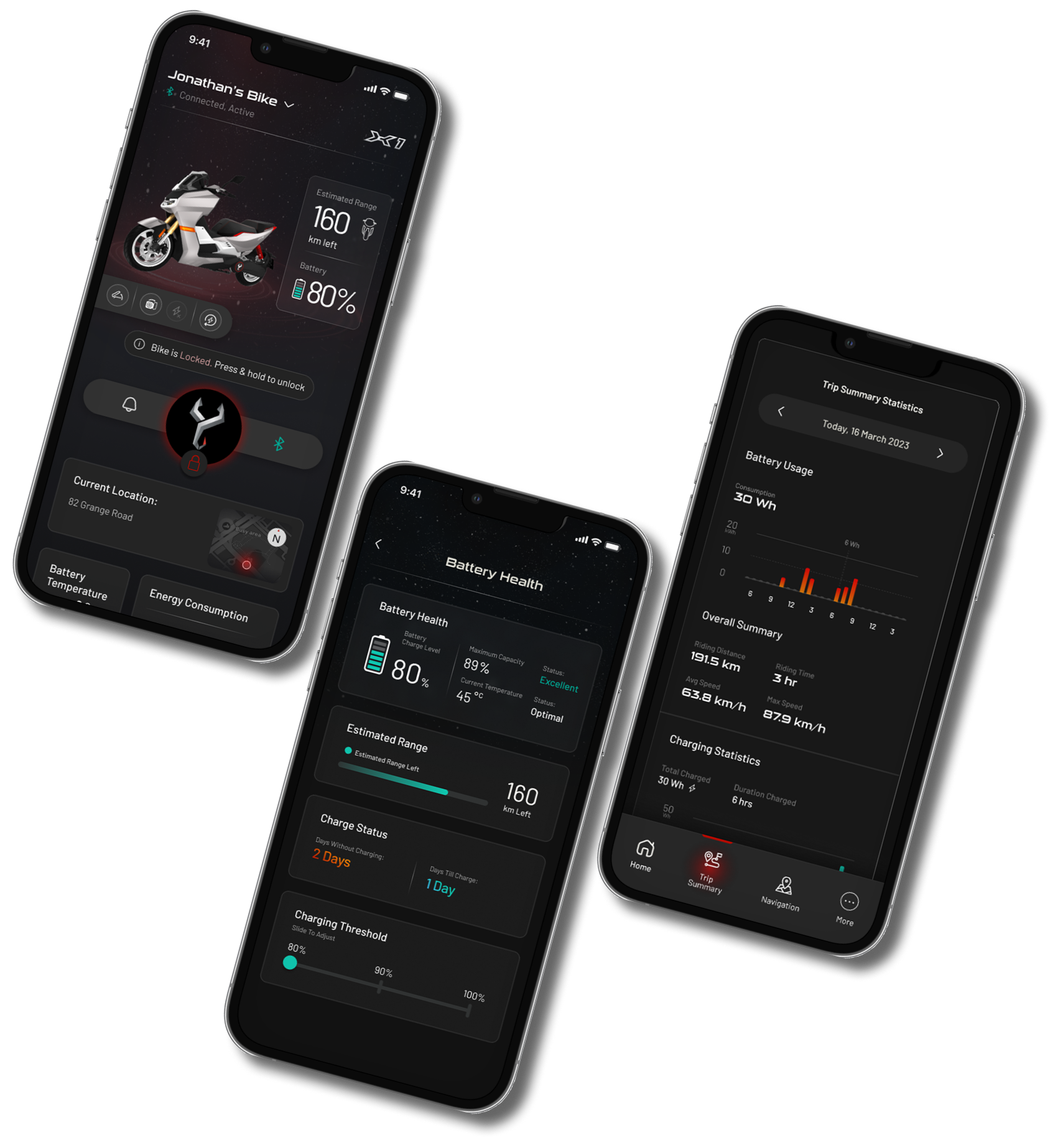
These ‘software features’ have been the clear differentiators between an electric scooter or motorcycle and an ICE machine. With the smart user interface, electric machines have made ICE machines decidedly last-gen tech.
But are they? Is this virtual gap in tech a gap? As an assessment, we decided to pick the best from VMoto, Niu, Ather Energy, Ola Electric, Xiaomi-Segway, and TS Verge to see what features are offered and what difference they make.
Most importantly, we wanted to assess if the energy source caused a differentiation, and an ICE machine could never replicate this practically. We started with a long list to explore if there are features that only an EV can have. Post our analysis, we could differentiate features into three broad categories:
- The ICE advantage: ICE only features that are almost impossible to replicate in EVs
- The No Advantage: Power-source agnostic features – a zone where ICE and EVs have no advantage against each other.
- The EV Advantage: Features where EVs have an advantage over ICE machines.
The ICE Advantage
ICE has little advantage in terms of ‘features.’ Where it shines through is in delivering a well-rounded user experience. The ICE advantage shines through in delivering an experience that the riders are used to—from the exhaust note to the vibrations and drama, ICE motorcycles beat E2Ws hands down.
Another area where ICE has an edge over EVs is the gearbox. The ICE engine is tactile, and the gearbox mated to it ensures we solve for torque at the bottom and power at the top. It is challenging to do so with electric motors.
Weight is another area where ICE scores over electric motorcycles. Weight impacts handling, and it is challenging to engineer a nimble electric motorcycle.
This was discussed in detail in our previous posts, where we wrote about how difficult it is to engineer a lifestyle electric motorcycle.
Arguably, the above are not features but core engineering. In terms of ‘features’, ICE has hardly any edge over E2Ws.
The No Advantage Zone
Some features are powertrain agnostic and can be equally well-delivered by both E2Ws and ICE. Typically, these include anything that uses mechanical linkages and/or small sensors that can run off 12V easily. Some are:
A Unified or Combined Brake System (UBS/CBS) ensures that front and rear brakes are used simultaneously. This system operates through mechanical linkages/cables and will work regardless of the power source.
ABS works the same way in both ICE and Electric two-wheelers. Neither ICE nor EVs have an edge here. However, large E2W startups would be tempted to code on their own and not outsource things to a BOSCH or Conti. This may be partly due to cost constraints and partly due to the speed of execution that the suppliers have – they often need 4-6 months to calibrate the system for any vehicle.
There are also ABS modes that control the extent of the ABS’s control. These work similarly and equally well, regardless of ICE or EV.
Suspension Settings depend on the kind (and price) of suspension being deployed. It doesn’t matter if the machine is ICE or EV.
Traction Control works in ICE by modulating the engine torque. Its applications in EVs are similar—modulating the motor when it detects wheel spin or a difference in rotational speed between the two wheels. Again, there is no advantage in being ICE or EV. Theoretically, EVs should have an implementation advantage, but ICE had a head start, and they have mastered the tech. EVs still have to catch up to do. The characteristic difference may be that the ICE world relies on BOSCH or some other supplier, while the EV world would be fiddling with the code themselves.
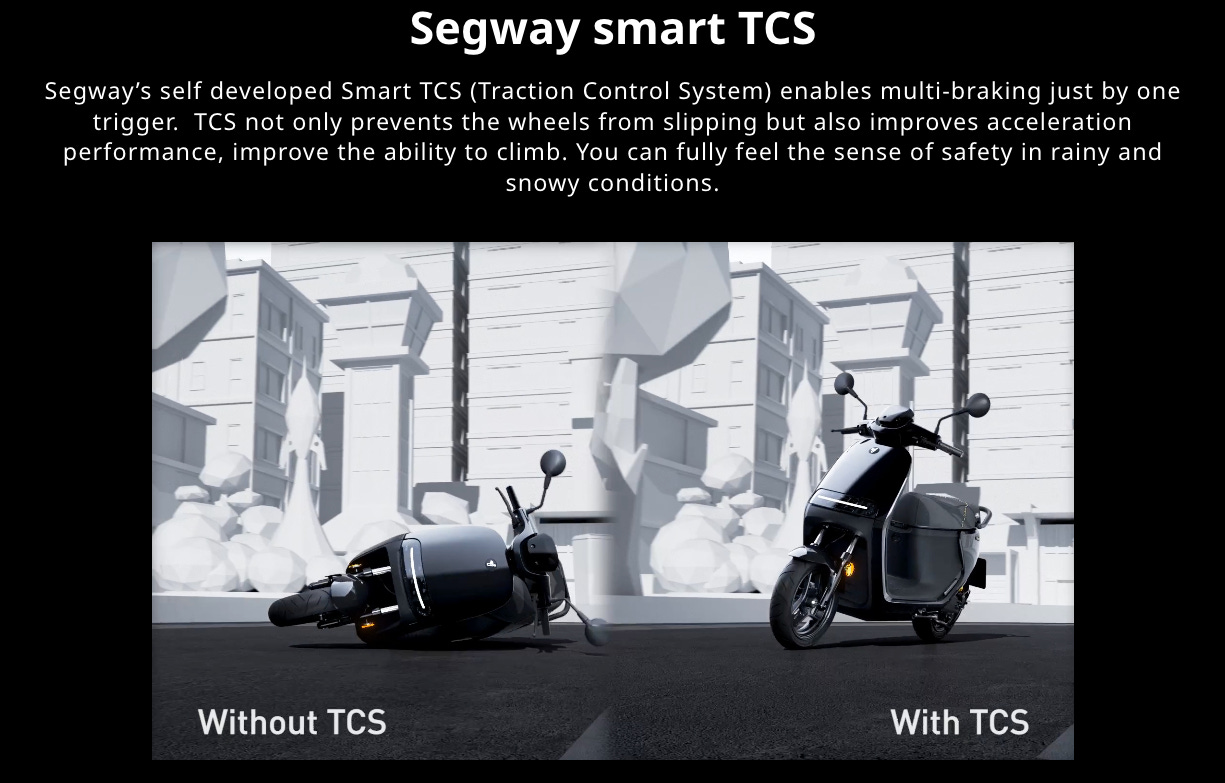
Several other related systems – cornering ABS, cornering traction control, motorcycle stability control, etc.- aid safety and are now available in high-end motorcycles. The complexity and component requirements remain the same in electric and ICE applications. In almost all of these cases, the top rung of the ICE world has a headstart as they have been working with suppliers for the last five years.
Cruise Control is a welcome feature on motorcycles used for long-distance touring. The Honda Goldwing was one of the first to have it. The feature works with an electronic throttle lock to keep the speed steady. This feature does not percolate downwards in ICE machines very well – the user demand vs the BoM cost increase equation does not play out well. However, the implementation is much simpler in EVs and, in almost all cases, can be achieved through software control of the motor. Presto, even basic commuter scooters, flaunt a cruise control feature.
We pause here to point out that as daily users of EVs – both 2Ws and cars – we find the Cruise Control feature a great battery saver. In the CC mode, the motor draws optimal current from the battery, something not possible with manual throttle control. Cruise Comntrol ends up being a range enhancer. It still remains useless while whining around town.
Adaptive Cruise Control adds radars and cameras to the equation; nothing stops ICE motorcycles from adding them. Most top-of-the-line tourers have that, even though it somewhat breaks the smoothness of the front fairing. The tech implementation on an electric motorcycle/scooter won’t be any different. However, the EV’s natural propensity to sensors and software means they will likely adopt this tech faster. On the negative side, the associated BoM costs are a big negative for the EV industry, which also has a propensity not to make money.
Tire Pressure Monitoring Systems are increasingly common. There are two types of systems: one that uses direct sensors inside each tire. These systems are expensive, but they get accurate data from each tire on the dash. The other is a sensor-software system that measures wheel spin and can only provide a warning when the pressure is low. Both types of sensors are not affected by the powertrain choice and can be deployed irrespective.
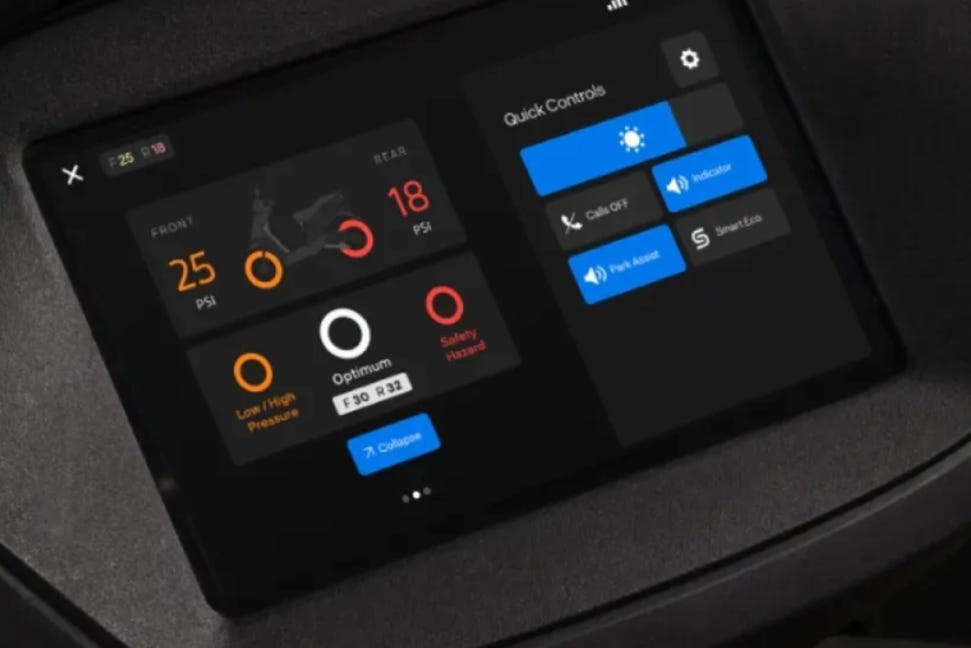
Hill Hold or Slope Park Systems are common nowadays in ADV and Motocross machines. They are effective and useful in off-road conditions. In ICE machines, such a system involves having sensors that detect that the motorcycle is on a slope and that it is at a standstill (from the clutch and gear position) and expected to remain so even though the rider has released the brake. The Hill Hold will keep the brakes applied. This is simple and effective – the two key outcomes are that the motorcycle does not roll back and that the rider is not tired of keeping the brakes pressed. We have seen such systems decades back in ICE automatic commuter scooters where an outside clip mechanism would lock the brakes. You could release the brake lever, but the clip would keep it locked.
Manual, but equally effective.
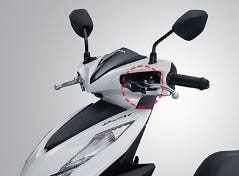
Some EV manufacturers have unnecessarily complicated the system, where the system is rigged through a chain of sensors that detect the slope, the standstill position of the vehicle, and the brakes that have been released. They keep the vehicle from rolling back by applying sufficient motor torque to counter the roll. There are some negatives – sensors go bust once in a while, and they are costly. Also, applying motor torque depletes the battery, and to avoid that, manufacturers design the Hill Hold to be released after 3-4 minutes.
The mechanical clip was more effective and cheaper.

